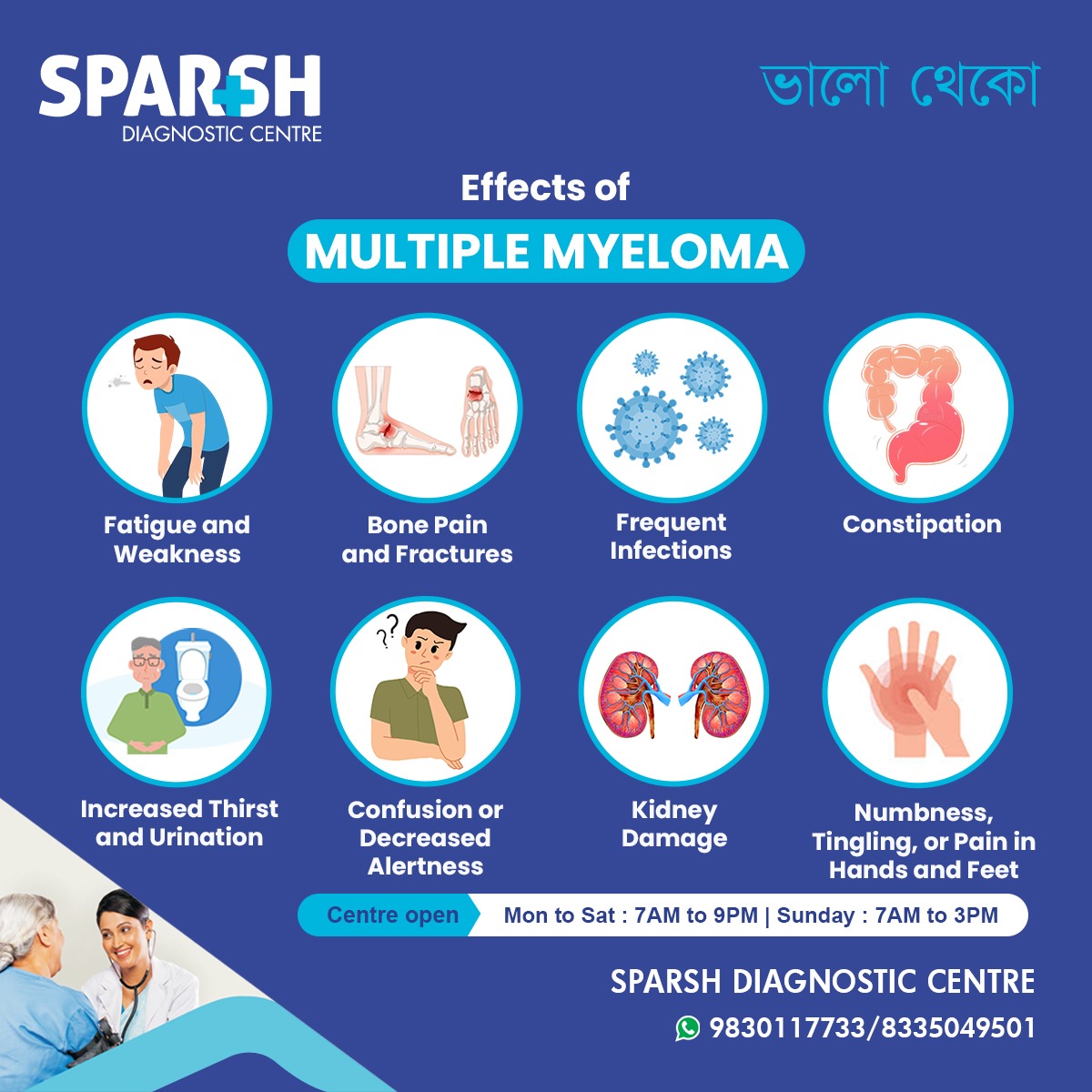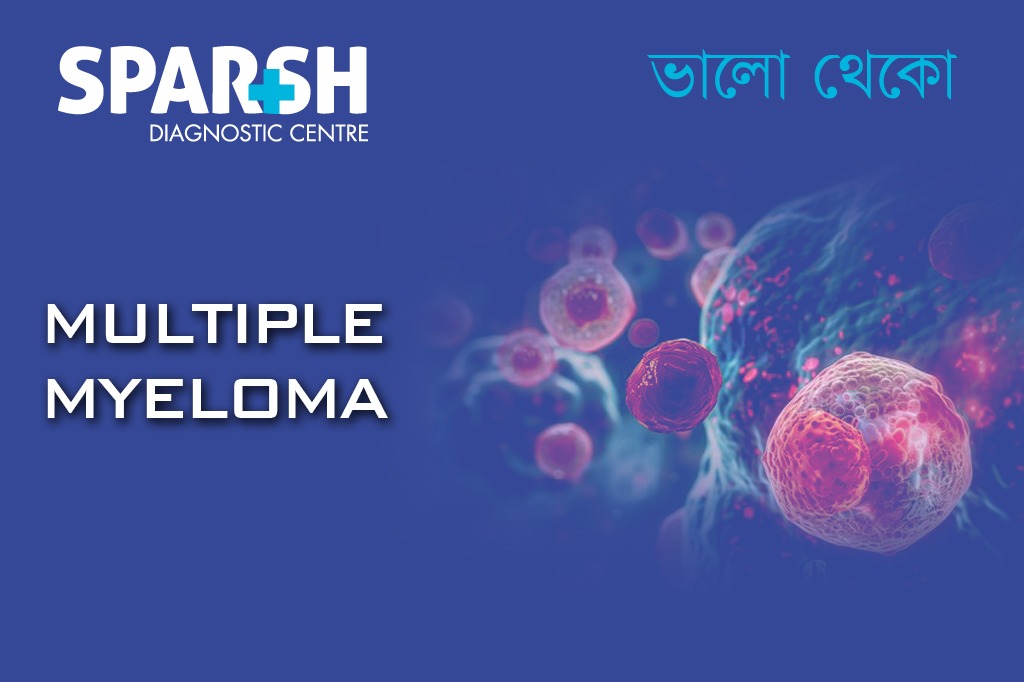Multiple Myeloma is a type of blood cancer that develops in plasma cells, a kind of white blood cell found in bone marrow. Plasma cells play a vital role in the immune system by producing antibodies (immunoglobulins) that fight infections. In Multiple Myeloma, these plasma cells become abnormal, multiply uncontrollably, and crowd out healthy blood cells. This leads to weakened immunity, bone damage, anemia, and kidney problems.
According to global cancer statistics, Multiple Myeloma accounts for nearly 10% of all blood cancers. While it is more common in older adults, it can affect individuals of varying ages. Early diagnosis and timely treatment are crucial for managing the disease and improving quality of life.
In this article, we’ll explore the causes, symptoms, complications, diagnosis, treatment options, and lifestyle tips related to Multiple Myeloma.
What is Multiple Myeloma?
Multiple Myeloma is a cancer of plasma cells, which are responsible for producing antibodies. In this condition:
Abnormal plasma cells produce excessive amounts of a single antibody known as monoclonal protein (M protein).
The buildup of M protein damages organs, especially the bones and kidneys.
Overproduction of cancerous plasma cells weakens the immune system, leading to frequent infections.
Unlike some cancers that form solid tumors, Multiple Myeloma spreads within the bone marrow, making it a systemic disease.
Causes and Risk Factors of Multiple Myeloma
The exact cause of Multiple Myeloma is unknown, but several risk factors increase susceptibility:
Age – Most common in individuals over 60 years.
Gender – Men are at slightly higher risk than women.
Race – Higher prevalence in African-American populations.
Family History – Having a close relative with Multiple Myeloma or related conditions increases risk.
Pre-existing Plasma Cell Disorders – Conditions like Monoclonal Gammopathy of Undetermined Significance (MGUS) can progress to Multiple Myeloma.
Exposure to Radiation or Chemicals – Long-term exposure to radiation, pesticides, or petrochemicals may raise risk.
Obesity – Being overweight is associated with higher chances of developing plasma cell disorders.
Signs and Symptoms of Multiple Myeloma
Symptoms vary depending on disease progression. Some patients may have no symptoms in the early stages, while others develop multiple complications.
Based on your infographic, the effects of Multiple Myeloma include:
Fatigue and Weakness – Caused by anemia and reduced red blood cell production.
Bone Pain and Fractures – Cancerous plasma cells release chemicals that weaken bones, leading to frequent fractures.
Frequent Infections – The immune system is compromised due to abnormal antibody production.
Constipation – Linked to high calcium levels (hypercalcemia) from bone breakdown.
Increased Thirst and Urination – Also a result of hypercalcemia and kidney impairment.
Confusion or Decreased Alertness – Elevated calcium or kidney dysfunction may affect brain function.
Kidney Damage – Caused by excessive M protein accumulation in the kidneys.
Numbness, Tingling, or Pain in Hands and Feet – Resulting from nerve damage (peripheral neuropathy).

Other common symptoms include:
Frequent nosebleeds or bruising
Spinal cord compression (in severe cases)
Complications of Multiple Myeloma
If untreated, Multiple Myeloma can lead to serious complications:
Bone fractures and osteoporosis
Weakened immune system with recurrent infections
Neurological issues due to spinal cord compression or nerve damage
How is Multiple Myeloma Diagnosed?
Early diagnosis is essential for timely treatment. Doctors use a combination of blood tests, urine tests, imaging, and bone marrow biopsy to confirm the disease.
Key Diagnostic Tests:
Blood Tests
Complete blood count (CBC) – to check anemia.
Serum protein electrophoresis (SPEP) – detects M protein.
Calcium and kidney function tests.
Urine Tests
Bence-Jones protein test (detects abnormal proteins).
Bone Marrow Biopsy
Confirms abnormal plasma cell proliferation.
Imaging Tests
Treatment of Multiple Myeloma
Although Multiple Myeloma is not usually curable, modern treatments help control symptoms, slow disease progression, and improve survival. Treatment depends on the stage, patient’s age, and overall health.
1. Medications
Chemotherapy drugs – kill cancerous plasma cells.
Corticosteroids (dexamethasone, prednisone) – reduce inflammation and fight myeloma cells.
Targeted therapy – drugs like bortezomib, carfilzomib, or daratumumab attack specific cancer cell proteins.
Immunotherapy – strengthens the immune system to fight myeloma cells.
2. Stem Cell Transplant
High-dose chemotherapy followed by autologous stem cell transplant helps replace damaged bone marrow with healthy cells.
3. Radiation Therapy
Used to shrink tumors or relieve severe bone pain.
4. Supportive Treatments
Bisphosphonates – strengthen bones and reduce fracture risk.
Antibiotics & vaccines – prevent infections.
Dialysis – for patients with kidney failure.
Lifestyle and Self-Care Tips for Patients
Managing Multiple Myeloma requires medical care plus lifestyle adjustments:
Maintain a balanced diet rich in fruits, vegetables, lean protein, and whole grains.
Stay hydrated to protect kidney health.
Engage in light exercise like walking or yoga to improve bone strength and reduce fatigue.
Follow up regularly with your doctor for blood tests and scans.
Take prescribed medications on schedule.
Seek emotional support through counseling or support groups.
Living with Multiple Myeloma
A diagnosis of Multiple Myeloma can be overwhelming, but many patients live fulfilling lives with proper treatment and monitoring. With advancements in therapy, survival rates have improved significantly. Early intervention, ongoing medical supervision, and lifestyle adjustments can help manage the condition effectively.
FAQ Section on Multiple Myeloma
Q1. Is Multiple Myeloma curable?
No, Multiple Myeloma is generally considered incurable, but it can be managed effectively with modern treatments. Many patients live for years with controlled symptoms.
Q2. What is the average survival rate for Multiple Myeloma?
Survival depends on stage and response to treatment. With advanced therapies, many patients live 7–10 years or longer after diagnosis.
Q3. Can Multiple Myeloma be detected early?
Yes. Routine blood tests often detect abnormal protein levels before symptoms appear, making early diagnosis possible.
Q4. Does diet play a role in managing Multiple Myeloma?
Yes. A healthy diet supports immunity, reduces fatigue, and protects kidney function, though it cannot cure the disease.
Q5. What is the difference between MGUS and Multiple Myeloma?
MGUS (Monoclonal Gammopathy of Undetermined Significance) is a benign condition where abnormal plasma cells are present but not cancerous. In some cases, MGUS progresses to Multiple Myeloma.
Q6. How common is bone pain in Multiple Myeloma patients?
Bone pain, especially in the spine and ribs, is one of the most common symptoms and often the first sign of Multiple Myeloma.
Q7. Can Multiple Myeloma affect younger people?
Although rare, Multiple Myeloma can occur in younger individuals, but it is most common in those over 60 years of age.
Q8. How is kidney damage linked to Multiple Myeloma?
Excessive monoclonal proteins (M proteins) damage kidney filters, leading to reduced kidney function and, in severe cases, kidney failure.
Multiple Myeloma is a serious but manageable blood cancer that affects plasma cells in the bone marrow. With timely diagnosis, modern treatments, and supportive care, patients can manage symptoms, prevent complications, and maintain a good quality of life.
If you or a loved one experience persistent fatigue, bone pain, frequent infections, or kidney-related issues, it’s essential to seek medical guidance.
At Sparsh Diagnostic Centre, we provide advanced diagnostic tests and expert medical consultations to detect and manage conditions like Multiple Myeloma at the earliest stage possible.
👉 Book your health check-up today: Sparsh Diagnostic Centre
#BhaloTheko
Disclaimer:
No content on this site, regardless of date, should ever be used as a substitute for direct medical advice from your doctor or other qualified clinician.

![]()





